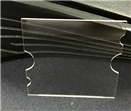

Time:2025-04-24
Sapphire lenses have a wide range of applications in the field of optics, especially in devices such as lenses, optical windows, and lasers, due to their high hardness, high transparency, and good chemical stability. However, to obtain high-quality sapphire lenses, ultra precision machining of their surface is crucial. Hydration polishing, as an efficient and scratch free ultra precision polishing method, plays an important role in the processing of sapphire lenses. This article will explore the principle and operation process of hydration polishing.
1、 Principle of hydration polishing of sapphire lenses
Hydration polishing is an efficient and ultra precision polishing method that utilizes the hydration reaction phenomenon generated at the interface of the workpiece to remove the hydration layer formed on the surface of the workpiece through the frictional force of the polishing disc for processing. Its principle is mainly based on the following aspects:
1. Activation under high temperature and high pressure: During the polishing process, friction occurs between the polishing disc and the sapphire lens surface, resulting in high temperature and high pressure at the contact point, which activates the atoms or molecules on the sapphire surface. This activated state makes it easier for aluminum and oxygen atoms on the sapphire surface to react with water molecules.
2. Hydration chemical reaction: Using superheated steam molecules and water to interact on the surface of sapphire, forming a hydration chemical reaction layer. The oxygen atoms on the surface of sapphire are polarized and easily absorb water molecules. Decompose adsorbed water molecules, allowing hydrogen ions to combine with oxygen on the surface of alumina to form hydroxyl groups (OH -), forming an activated complex and subsequently forming an Al-O * H2OH layer and AlO hydrate. The hardness value of this hydrated layer is lower than that of AlO, and it is easy to remove by the frictional force of the polishing disc.
3. Friction removal: Using the frictional force of a polishing disc to separate and remove the hydration layer from the surface of sapphire lenses in an environment of superheated steam or one atmosphere of steam, thus achieving mirror finish processing. This removal method avoids scratches on the surface of the workpiece caused by abrasive particles in traditional polishing, and can obtain a clean surface without scratches, smoothness, and lattice distortion.

2、 The process of hydration polishing of sapphire lenses
The hydration polishing process requires accurate control of polishing conditions to achieve the desired polishing effect. The following are the main steps of sapphire lens hydration polishing:
1. Preparation before polishing
① Workpiece cleaning: Clean the sapphire lens to remove impurities such as oil and dust on the surface, ensuring that the polishing effect is not affected by impurities during the polishing process.
② Polishing disc selection: Choose polishing disc materials that do not undergo solid-state reactions with sapphire lenses, such as cedar polishing discs. The hardness, roughness, and shape of the polishing disc should be selected according to the polishing requirements.
③ Polishing environment setting: Install a thermal insulation cover on the polishing machine to create a superheated steam environment. Adjust the parameters such as speed, pressure, and temperature of the polishing machine to meet the requirements of hydrated polishing.
2. Polishing process
① Start the polishing machine: Install the sapphire lens onto the polishing machine, start the polishing machine, and rotate the polishing disc and lens at high speed.
② Adding water vapor: Inject superheated water vapor into the polishing processing area to allow the surface of the lens to interact with superheated water vapor molecules, forming a hydration layer.
③ Polishing operation: During the polishing process, friction is generated between the polishing disc and the surface of the lens, and the hydration layer on the surface of the lens is removed using the frictional force of the polishing disc. By observing the reflected light during the polishing process or using tools such as microscopes to monitor the polishing effect, adjust the polishing parameters in a timely manner.
④ Polishing fluid usage (if necessary): In some cases, an appropriate amount of polishing fluid can be added to assist in the polishing process. The selection of polishing solution should be determined based on polishing requirements and lens material.
3. Polishing post-treatment
① Cleaning lenses: After polishing, clean the lenses to remove any remaining hydration layer and polishing solution on the surface.
② Quality inspection: Use optical microscopes, surface roughness measuring instruments, and other tools to inspect the surface quality of the lens to ensure that the expected polishing effect is achieved.
③ Protective measures: Properly store polished lenses to avoid adverse effects such as scratches and contamination.
3、 Precautions
During the hydration polishing process, the following points should be noted to ensure polishing quality and safety:
1. Control polishing parameters: The speed, pressure, temperature, and other parameters of the polishing machine have a significant impact on the hydration polishing effect, and should be accurately controlled according to the lens material and polishing requirements.
2. Regular maintenance of polishing equipment: The accuracy and stability of polishing equipment affect the quality of polishing, and it should be regularly maintained and serviced.
3. Operator training: Operators should receive professional training, familiarize themselves with the operation methods and precautions of polishing equipment, and ensure the safety and effectiveness of the polishing process.
4. Environmental control: During the polishing process, the working environment should be kept clean and stable to avoid the influence of impurities and temperature changes on the polishing effect.
Hydration polishing, as an efficient and scratch free ultra precision polishing method, has significant advantages in the processing of sapphire lenses. By accurately controlling polishing parameters and selecting appropriate polishing conditions, high-quality sapphire lens surfaces can be obtained.
藍(lán)寶石火焰探測器圖片.jpg)





Tel
Mobile phone
Customer service
TOP